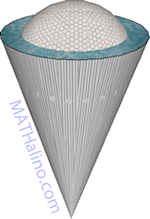035 Review Problem - Amount of concrete in a caisson
Problem 35
In the foundation work of the Woolworth Building, a 55-story building in New York City, it was necessary, in order to reach the bedrock, to penetrate the sand and quicksand to a depth, in some instances, of 131 ft. If the largest circular caisson, 19 ft. in diameter, was 130 ft. deep and was filled with concrete to within 30 ft, of the surface, how many cubic yards of concrete were required?



Recent comments
(…